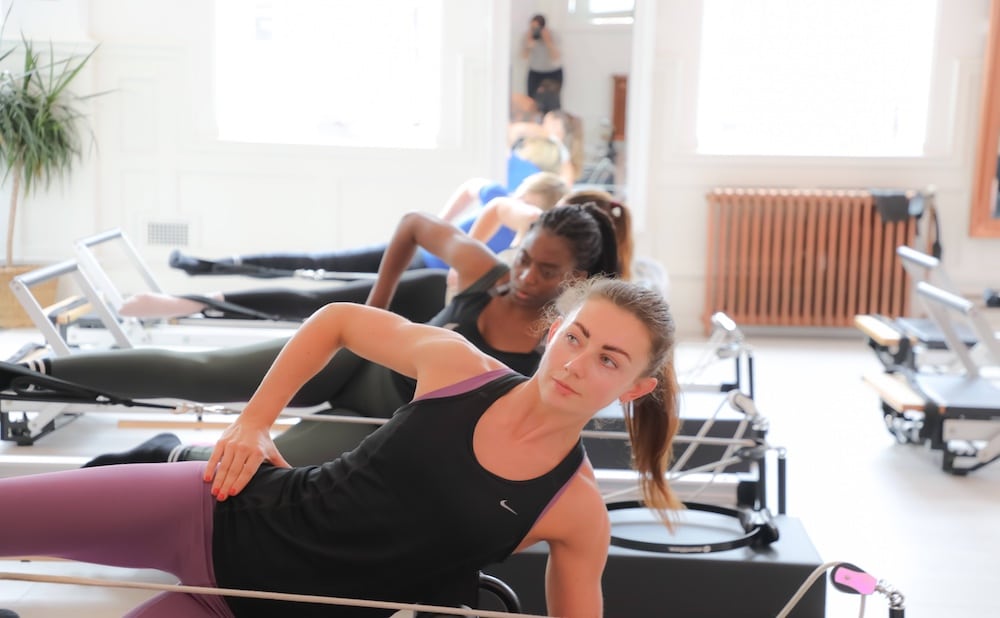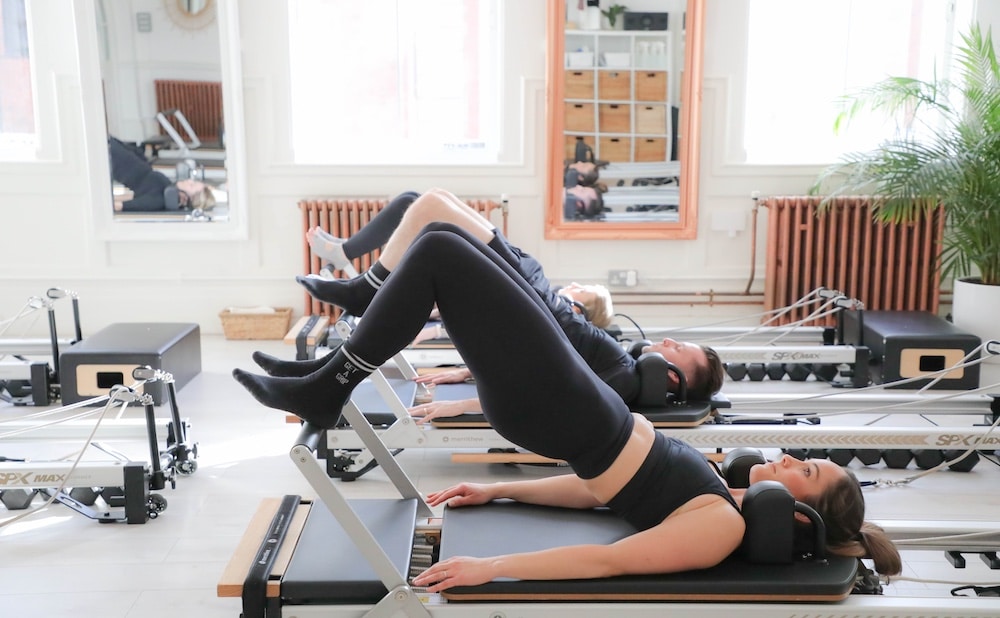Pilates can be highly effective for rehabilitation and injury prevention. It improves core strength, flexibility, balance, and overall body awareness, muscle and joint function and contributes to whole-body wellness.
Dynamic Pilates adds an extra layer of versatility and intensity to traditional Pilates exercises. It incorporates flowing, continuous movements that challenge the body’s strength, flexibility, and stability while maintaining the core principles of Pilates. For rehabilitation and injury prevention, Dynamic Pilates can be particularly advantageous because it fosters functional strength and mobility through a wider range of motion. As you progress you can safely load the muscle or joint to increase strength and mobility. Dynamic variations also introduce cardiorespiratory benefits, enhance muscular endurance, and promote calorie expenditure, making it an effective complement to traditional Pilates for those looking to rehab or prevent injuries.

10 Key Benefits of Pilates for Rehabilitation
1. Core Strength: Emphasizes strengthening the core muscles, including the abdominals, obliques, and lower back. A strong core helps stabilize the spine and improves posture, reducing the risk of injuries related to poor posture and weak muscles.
2. Flexibility: Exercises incorporate dynamic stretching movements that improve flexibility in muscles and joints. This increased flexibility can help prevent strains, sprains, and muscle imbalances.
3. Body Awareness: Encourages mindful movement and body awareness. By paying attention to how your body moves and feels during exercises, you can identify and correct movement patterns that may contribute to injuries.
4. Low-Impact: Exercises are low-impact, making them suitable for individuals recovering from injuries or joint issues. The controlled movements reduce the risk of overexertion and impact-related injuries.
5. Balance and Coordination: Involve balance and coordination challenges. By improving these aspects of fitness, you can reduce the risk of falls and related injuries, especially in older adults.
6. Posture Improvement: Helps correct poor posture habits that can lead to musculoskeletal issues and injuries over time. Proper alignment and postural awareness are essential for injury prevention.
7. Customization: Exercises can be adapted to individual needs and abilities. A trained instructor can modify exercises to accommodate specific injuries or conditions, ensuring a safe and effective workout.
8. Mind-Body Connection: This promotes a strong mind-body connection, which can be particularly beneficial during rehabilitation. Focusing on movement quality and breath control can enhance the healing process.
9. Stress Reduction: Chronic stress can contribute to muscle tension and increase the risk of injury. Pilates incorporates relaxation techniques and controlled breathing, which can help reduce stress and tension in the body.
10. Functional Strength and Mobility: The dynamic technique is based on the ‘isolate, fatigue stretch’ principle. A combination of traditional pilates moves in a more intense or dynamic method to build safely load the muscles and joints to increase the strength and function of the body.

Specific injuries and body parts that can benefit from Dynamic pilates training include a variety of muscular and joint injuries. Remember before starting a Pilates program for rehabilitation or injury prevention, it’s essential to consult with a healthcare professional or physical therapist, especially if you have existing injuries or medical conditions. They can guide the appropriate exercises and modifications for your specific needs.
1. Back Injuries:
Strengthening Core Muscles: This places a strong emphasis on core strength, which can help stabilize the spine and reduce the risk of reinjury in cases of lower back pain or disc issues.
Improved Posture: Pilates exercises promote better posture, reducing strain on the back and preventing recurrent pain.
Flexibility: Pilates incorporates stretching, which can relieve tension in the back muscles and improve spinal mobility.
2. Hip Injuries:
Hip Flexor Strengthening: Pilates exercises target the hip flexor muscles, promoting strength and flexibility to aid in hip injury recovery.
Improved Range of Motion: Controlled movements in Pilates can help increase hip joint mobility, crucial for rehabilitation.
Glute Activation: Strong glute muscles are essential for hip stability, and Pilates can help activate and strengthen these muscles.
3. Knee Injuries:
Quadriceps and Hamstring Strengthening: Pilates includes exercises that target the quadriceps and hamstrings, which are vital for knee stability and injury prevention.
Balance Training: Pilates can improve balance and proprioception, reducing the risk of falls and further knee injuries.
Low Impact: Pilates is low-impact, resistance training, making it suitable for individuals with knee issues.
4. Ankle Injuries:
Ankle Stability: Pilates can help strengthen the muscles around the ankle joint, improving stability and reducing the likelihood of sprains.
Proprioception: Pilates exercises that challenge balance can enhance proprioception, which is essential for preventing future ankle injuries.
Gradual Progression: Pilates allows for gradual increases in intensity, making it ideal for gradually rebuilding strength and flexibility in the injured ankle.
5. Shoulder Injuries:
Rotator Cuff Strengthening: Pilates exercises can target the rotator cuff muscles, aiding in the rehabilitation of shoulder injuries.
Scapular Stability: Pilates emphasizes scapular stability, which is essential for proper shoulder function and injury prevention.
Postural Awareness: Pilates helps individuals become more aware of their posture, reducing the risk of shoulder strain due to poor alignment.
6. Wrist Injuries:
Grip Strength: Pilates exercises can be adapted to improve grip strength, which is crucial for wrist rehabilitation and overall health.
Weight-Bearing Modifications: A trained instructor can modify exercises to reduce pressure on the wrists during the recovery phase.

Dynamic Pilates can be adapted to accommodate various injury types and stages of recovery, making it a valuable tool in helping individuals regain full functionality and prevent future injuries. As with any form of exercise, it’s crucial to work with a knowledgeable instructor who can tailor dynamic Pilates routines to meet your specific rehabilitation and injury prevention goals.